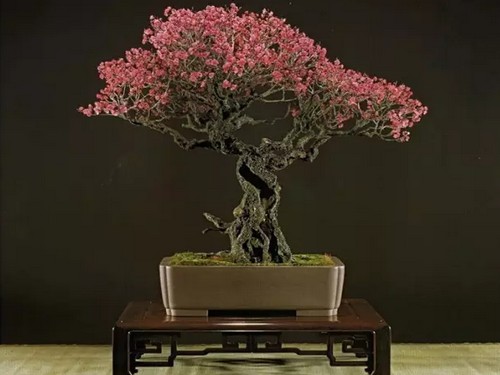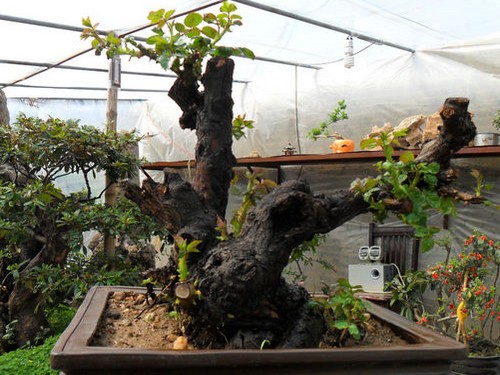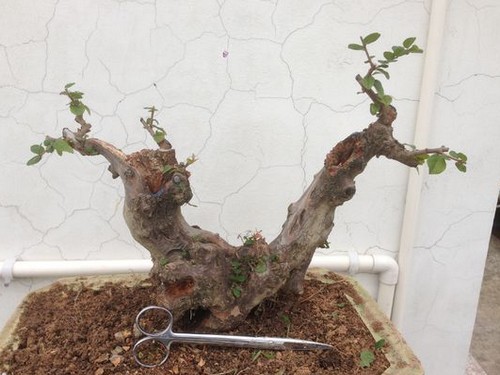Material selection and cultivation methods of miscellaneous wood bonsai
The miscellaneous wood in bonsai refers to the artistic processing and modeling of bonsai based on the ancient alpine trees in nature, so as to achieve the purpose of shrinking the dragon into an inch, and cultivate it into works of art derived from nature and higher than that of nature, which is a non-renewable resource. The following is to introduce the selection and cultivation methods of miscellaneous wood bonsai.

Pick piles:
The stump should be dug timely, usually after the fallen leaves, and can be dug from the end of autumn to April 20 of the following year. When digging the pile, the diameter of the pile root plate is 1 or 5 times the thickness of the root plate, and the groove width is 15 cm. The root is cut off when you see the root, and the coarse root is cut off by sawing the small root until the bottom, hollowed out on all sides and then sawed to fix the root. Do not use a big pick to pry disorderly, leave the branches a little longer after the pile, easy to transport, the pile must be moisturized, wrapped in plastic bags to avoid water loss.
Cut piles:
Before cutting the pile, you should carefully observe the pile material, pull it back and forth from multiple angles, tilt and examine it, and cut it according to which type it is suitable for. The height and length of the cut pile should be one bud point longer than the reserved standard. Including the root should be in place in one step, so that the second operation will not be time-consuming and risky. Each section should be flattened and smeared with healing agent, and then sprayed to kill insects.
Planting piles:
Under the condition of local planting, it is best to plant shallow and high accompany, and the mound should be as large and thick as possible, which is convenient for anti-freezing. No planting conditions can be self-made wooden box or foam box large pot can, the best plain soil granular soil, vegetable garden soil pond mud or fertile old basin soil must not be used. When planting piles, they should be planted according to the selected angle and good potential. This is very important for the determination of branches in the stump stage. After the new pile is planted, it should be wrapped with plastic wrap to keep it moist.
Fixed branch:
After the stump survives, there is basically no need to change the original selected tree pattern. When the branches grow to 15 to 20 centimeters, the useful branches can be left according to the shape of the tree, and the useless branches can be erased, or some spare branches can be left suitably. If there is no bud in the ideal position, the spare branches can be used for pulling and mending. When the branches grow to 40 to 50 centimeters, you can shake the roots of the branches to make them thicker. At the same time, the silk is bent to adjust the angle of the branch. When fixing branches, it is necessary to arrange the position of main branches, floating branches and falling branches, and locate them according to the method of bonsai. To achieve the four branches of octagonal cloth, the second rotation is not pressed down, echoing the struggle to give way at first. Never leave only the left and right branches, lest the tree is thin. To reach, the main branch, the left front branch, the right front branch, the back branch, the right back branch, the left back branch, all aspects. This is convenient for creative transformation in case it is transferred in the future.
Stocking:
After the branch is positioned, the big water and fat allow it to grow madly, during the stocking period, the vigorous growth of the top branch should be strictly controlled, even if the proportion of thickness is not enough, it should be cut frequently. Focus on the cultivation of the lower main branches and lateral branches. Whichever branch needs to grow thick, let the branch grow madly. After the free-range branch is bent, some small cross-angle branches will grow in the second half, which can be used to reserve the second-class branches. The third-order branches can be cultivated by growing cross-angled branches on the secondary branches. In each grade change, it is necessary to reserve suitable bud points according to the shape of the branches and veins. When controlling the top branch, it should also be cut according to the direction of the top branch, defection and leaving buds. The topping echoes with the main branch. During the stocking period, the roots should also be adjusted. After three to four years of stocking, twigs and twigs can be cultivated in pots. In this way, as long as the pile is no more than 20 centimeters thick, it can be formed in four to five years. Beginners might as well give it a try.
In fact, what is said above is also basic common sense. Old voices often talk about it. The key to bonsai is to make branches, and the method of branches is the method of making branches. However, the natural characteristics of different tree species are different, so the techniques and methods of making branches are also different. Communication will be discussed in detail in the future. I hope the teachers will correct and correct what is wrong.
Time: 2019-06-02 Click:
- Prev

Field Stacking and Grafting Techniques of Ancient Stump Rose Bonsai
Every spring to the hillside, ditch edge excavation pile unique, natural sharp rose pile. After the pile is picked back, the root trunk shall be cut in place as far as possible, planted with a little sawdust infiltrated with plain sand, potted land planting can be carried out, the whole pile shall be covered with plastic bag, and the plastic bag shall be removed on rainy days after the new bud grows 3-5cm.
- Next

Time and method of picking old pile bonsai of sparrow plum
The climate in the south is warm, the dormancy period of plants is short and the sprouting is early. The best pile picking period is from Lesser Cold to Greater Cold. Tree-sparrow plum after dormancy, accumulated a lot of nutrients, conducive to germination and rooting. Roots and buds complement each other. Both of them grow well to ensure the survival of the stump.
Related
- Fuxing push coffee new agricultural production and marketing class: lack of small-scale processing plants
- Jujube rice field leisure farm deep ploughing Yilan for five years to create a space for organic food and play
- Nongyu Farm-A trial of organic papaya for brave women with advanced technology
- Four points for attention in the prevention and control of diseases and insect pests of edible fungi
- How to add nutrient solution to Edible Fungi
- Is there any good way to control edible fungus mites?
- Open Inoculation Technology of Edible Fungi
- Is there any clever way to use fertilizer for edible fungus in winter?
- What agents are used to kill the pathogens of edible fungi in the mushroom shed?
- Rapid drying of Edible Fungi

